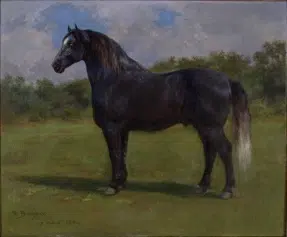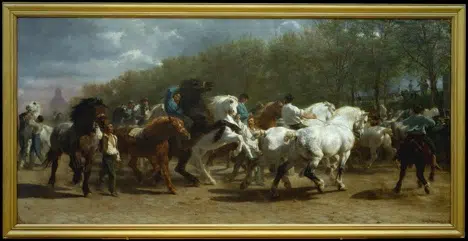The following article was written by Natasha F. Khan, Collections Assistant at the Rahr-West Art Museum for the Art Forward series.
Rosa Bonheur 1822 (Bordeaux, France) -1899 (Fontainebleau, France)
“Art is a tyrant. It demands heart, brain, soul, body. The entireness of the votary. Nothing less will win its highest favor. I wed art. It is my husband, my world, my life dream, the air I breathe. I know nothing else, feel nothing else, think nothing else.” – Rosa Bonheur
Rosa Bonheur was a feminist, Realist, French painter and sculptor who became famous for her accuracy and detail of the animals and scenery in her work, as well as for the “unconventional” way she lived. She had a lifelong love and appreciation of animals, having a variety of animals as pets throughout her life. Rosa defied gender norms from a young age, preferring to dress in pants, wear her hair short, smoked, and lived openly with her partner. To paint and sketch freely in the Louvre, public spaces, horse markets and areas that were commonly for men, Rosa petitioned authorities to wear men’s clothing to work undisturbed by men. She was one of only a few women who received such permits to do this.
Rosa received her training from her art teacher father as well as Leon Cogniet, another French painter. Her father, Raimond Bonheur, taught her Henri de Saint-Simon’s principles that forever influenced her thinking of work, property, marriage, role of women in society, traditional gender norms, equality, educating women, and art. Henri de Saint-Simon was a French social theorist and one of the founders of Christian socialism. He foresaw the industrialization of the world, believed that science and technology would solve most of humanity’s problems, and advocated for a society that was controlled by businessmen and industrial leaders not the military. Rosa’s father left the family when she was 11 to further follow Saint-Simon’s principles.
Her work was regularly exhibited at the Paris Salon from 1841-1853. She also won many medals for her work, including the cross of the Legion of Honor in 1865 by the French Empress Eugenie. Rosa also had a porcelain doll created in her honor that circulated around the world, as well as a porcelain vase by the French government. Some of her most famous pieces include: The Horse Fair, Plowing in the Nivernais, Spanish Muleteers Crossing the Pyrenees, Sheep by the Sea, Weaning the Calves, the Lion at Home, and Portrait of Colonel William F. Cody. The Rahr West Art Museum’s piece is Madere. The museum also has a piece by Rosa’s brother Isidore Bonheur. To finesse her art, Rosa diligently studied animal anatomy, going so far as to visit farms, animal markets, horse fairs, and slaughterhouses to figure out exactly how animals moved. Royals, statesmen, celebrities, and governments commissioned Rosa during her many years of creating art.

Madere by Rosa Bonheur, oil, 1884 from the collection of the Rahr-West Art Museum, 80.78.2, Gift of Mrs. John D. West
Rosa lived with her partner Nathalie Micas until Nathalie’s death in 1889. After a long mourning period she met an American portraitist, Anna Klumpk, and after years as pen pals, she lived with Rosa until her death in 1899. Rosa was buried in Paris at Pere Lachaise Cemetery alongside Nathalie. When Anna died in 1945 her ashes were interred with them.
Anna painted this portrait of Rosa during their time together and even wrote her biography for her. After Rosa’s death, Anna dedicated the Musee Rosa Bonheur to her and created the Rosa Bonheur Memorial Art School to offer instruction for women. The Chateau they lived in, Chateau de By at Thomery, was purchased in 2017 by Frenchwoman Katherine Brault. She purchased Rosa’s Chateau from Anna Klumpk’s family. Katherine is dedicated to preserving Rosa Bonheur’s legacy and to open up the home as a museum. During the pandemic she had ample time to dig through the Chateau and has found many eye-opening things that help shed a light on the fascinating person Rosa was. Many rooms have been preserved exactly how they would have been during Rosa’s life, filled with artist tools, paintings, animal horns and antlers, a bagpipe, taxidermied animals, the fur of her pet lioness, unfinished paintings and sketches, and much more. The Chateau is said to have more than 50,000 works of arts, objects, and documents.
Rosa Bonheur is one of many artists who today would be a member of the feminist movement and LGBTQ+ community. Her work and lifestyle further shows that both communities have always been around and have made incredible contributions to art history and so much more. March is Women’s History Month and what better way to celebrate than to uplift and educate ourselves on one of the many influential women of art history. “I am proud to be a woman, and to the end of my years I shall uphold the rights of women in all professional work and in all honorable endeavors. It belongs to us women to elevate the human race.” – Rosa Bonheur





